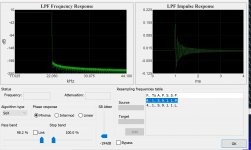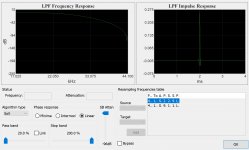An Invitation To Lurkers
All lurkers are invited to participate in our 176.4kHz high performance upsampling evaluation. In fact, the more, the merrier. The test files can be found in Dropboxes via this post from Hans Polak https://www.diyaudio.com/forums/digital-line-level/371931-makes-nos-sound-130.html#post6743164.
We welcome you to join in the fun. 🙂
All lurkers are invited to participate in our 176.4kHz high performance upsampling evaluation. In fact, the more, the merrier. The test files can be found in Dropboxes via this post from Hans Polak https://www.diyaudio.com/forums/digital-line-level/371931-makes-nos-sound-130.html#post6743164.
We welcome you to join in the fun. 🙂
...... Regarding John's observation of NOS having a "dirty" sound, Abraxalito, in post#35 .....
Here are two reports of the same clangy sound on piano with NOS on two different DACs with different ears:
...biggest weakness of NOS was uneven HF which would manifest (for example) as 'clanginess' on close-mic'd piano. abraxalito
Acoustic solo close mic'd piano is a great choice for any test tracks for critical listening. There might be something about the harmonic timbre of piano that is able to reveal issues...the NOS piano acquired a clangy quality at climaxes John Atkinson
The analogue US filter abraxalito designed, implemented and found abolished the clangy sound, certainly implicates the US noise from NOS as the culprit. It might be presumptuous to just assume that US is the problem? Further testing seems warranted?
An easy test for someone with a true NOS DAC would be use a software oversampling filter that can let through different amounts of US while listening. Resampler-V in Foobar has sliders to allow that. Easy and free. Indeed resampler-V with Foobar allows listening to SOX, with control over most filter parameters in near real time:
Attachments
Last edited:
NOS does have a weakness in high frequency roll-off (it's not really a weakness, it's just that NOS doesn't care about correcting it like other OS DAC's).
But NOS weakness is NOT if the poorly recorded piano sounds exactly like that - a poorly recorded piano. This is NOS benefit - it shows how poorly the piano was recorded. I have friends in the music business; they do a lot of studio recordings, this is just common knowledge.
Each octave should have its own mic. Sometimes 7-8 mics are required for this. Otherwise, the top octaves will sound distorted, and NOS will show it.
The OS / DSD DAC's / complicated analog reconstruction filters will mask this clanginess; this doesn't mean NOS is bad, on contrary.
But NOS weakness is NOT if the poorly recorded piano sounds exactly like that - a poorly recorded piano. This is NOS benefit - it shows how poorly the piano was recorded. I have friends in the music business; they do a lot of studio recordings, this is just common knowledge.
Each octave should have its own mic. Sometimes 7-8 mics are required for this. Otherwise, the top octaves will sound distorted, and NOS will show it.
The OS / DSD DAC's / complicated analog reconstruction filters will mask this clanginess; this doesn't mean NOS is bad, on contrary.
Last edited:
.....But NOS weakness is NOT if the poorly recorded piano sounds exactly like that - a poorly recorded piano. ..
The notion that a "clangy" sound listening to solo piano via NOS can be blamed on poor recordings seems unlikely.
abraxalito appears to be highly experienced in listening to recorded piano music and so would be expected to pick up on bad recordings:
As my listening diet includes a large proportion of solo piano this was a significant drawback for NOS.
John Atkinson has a depth of recording experience, listened to the actual instrument he recorded and could replay back on multiple systems over many years:
The biggest difference between the two modes was with solo piano recordings. My recording of Liszt's Liebestraum, performed on a Steinway D piano by Robert Silverman (from Sonata, Stereophile STPH008-2), sounded equally palpable in DSD and NOS modes. However, the NOS piano acquired a clangy quality at climaxes, while the DSD piano remained clean and closer to the sound of the instrument with the Weiss DAC502 decoding the digits.
Does anyone have a NOS DAC, other then a Holo May and would mind listening to the above piano track or other piano tracks in NOS and then with software OS?
And is there a non NOS DAC owner that can attest to the the recording sounds really clean? This is (one thing) what is so hard with these kind of tests, the reference material. Its no enough with some "nice" tracks. I think that non clipped, non processed acoustical recordings is the only viable sound material. Anything "processed" and what do we know - it just becomes a relative reference? Like "I think the (artificial and added in post) reverb sounded better on DAC Z"...
//
//
Last edited:
I would say that anyone can with a proper set of mics and a better sound card. But there is still the question of - how did it sound... 🙂
I will soon be able to do it even better than before. Placing mics is a knowledge not easily acquired and I'm a mere student...
But I see now that you probably mean to check if it sounds clean.. so - yes.. but thats just me... age, speakers, amps, DACs and all... 🙂
/
I will soon be able to do it even better than before. Placing mics is a knowledge not easily acquired and I'm a mere student...
But I see now that you probably mean to check if it sounds clean.. so - yes.. but thats just me... age, speakers, amps, DACs and all... 🙂
/
Here is an example from a DPA mic comparison CD. I dare upload it as it is a part of a commercial promotion from DPA... its sound really clean to me.
I see now:
"Companies, etc.
Copyright (c) – Niels Thybo
Recorded At – Radiohusets Koncertsal
Credits
Concert Grand Piano – Niels Thybo
Engineer – Jan Oldrup, Mikkel Nymand, Peter Scheelke
Notes
Niels Thybo plays Radio Denmark's Steinway concert piano.
Recorded in Radio Denmark's concert hall, February 5, 2007.
Recorded with Digital Audio Denmark AX24 mic amps and converters to Merging Pyramix DAW in DXD resolution (24 bit 352.8 kHz PCM sampling).
No equalization, compression, or external effects have been added to the files.
All stereo pairs are normalized to -2 dB FS PCM, allowing true impulse responses of the different pairs to be compared.
Stereo-only recording.
Not for sale. For demonstration purpose only."
Well, I claim fair usage and it's and excerpt for reference 🙂
//
PS. When I play this track on my system it strikes me how much of the phongrams out thare seem to be laden with a lot of distorsion...
I see now:
"Companies, etc.
Copyright (c) – Niels Thybo
Recorded At – Radiohusets Koncertsal
Credits
Concert Grand Piano – Niels Thybo
Engineer – Jan Oldrup, Mikkel Nymand, Peter Scheelke
Notes
Niels Thybo plays Radio Denmark's Steinway concert piano.
Recorded in Radio Denmark's concert hall, February 5, 2007.
Recorded with Digital Audio Denmark AX24 mic amps and converters to Merging Pyramix DAW in DXD resolution (24 bit 352.8 kHz PCM sampling).
No equalization, compression, or external effects have been added to the files.
All stereo pairs are normalized to -2 dB FS PCM, allowing true impulse responses of the different pairs to be compared.
Stereo-only recording.
Not for sale. For demonstration purpose only."
Well, I claim fair usage and it's and excerpt for reference 🙂
//
PS. When I play this track on my system it strikes me how much of the phongrams out thare seem to be laden with a lot of distorsion...
Attachments
Last edited:
John Atkinson has a depth of recording experience, listened to the actual instrument he recorded and could replay back on multiple systems over many years:
How many NOS Dacs have been auditioned by JA.
The ones I know are HifiMan and BorderPatrol.
BorderPatrol Digital to Analogue Converter SE Measurements | Stereophile.com
Head-Direct HiFiMan HM-602 Digital Audio Player Measurements | Stereophile.com
Both having miserable test figures like extreme jitter, non linearity errors, large differences between both channels, etc, etc.
So using the listening experiences he had with NOS Dacs must be treated with great care.
Hans
How many NOS Dacs have been auditioned by JA.
The ones I know are HifiMan and BorderPatrol.....
It doesnt look like JA actually auditioned i.e critically listened to either of those NOS DACs - he just measured them. So his NOS DAC comment was about the May DAC, which he was very clear about. Whats interesting is he described exactly the same issue as abrax. mentioned down to the same description of "clangy" sound, but with different DACs in NOS mode.
For the NOS DAC true believers JA really liked the NOS mode and indicated he would try it with most tracks. Its a pity JA didnt try computer OS vs NOS, in PCM NOS mode, to see if its possible to get the best of NOS and OS combined.
Can anyone recommend a true NOS DAC with USB input good for 384kbit to allow computer upsampling fun at home?
Cats certainly get annoyed by THD distortion in this range, but:
Who knows whether cats get annoyed by a presence of coherent images?
A part of Sony propaganda when introducing SACD was promoting a wide bandwith amplifiers and speakers. Many years passed since SACD died and there are still positive aspects of this campain.
The only way to really find out what a NOS DAC with only zero order hold reconstruction sounds like to a cat is to die, reincarnate as a cat and find personnel with such a DAC, but as an experiment to get a first impression, I've scaled everything by two octaves.
The attached zip contains a 10 second music excerpt band limited to 5 kHz, this is roughly what an OS DAC playing 44.1 kHz sample rate audio should sound like to a cat (two octaves too little on the treble side).
The other has the band-limited signal subsampled at 11025 Hz and all samples repeated four times. This is roughly what a NOS DAC playing 44.1 kHz sample rate audio should sound like to a cat (two octaves too little on the treble side and spectral copies).
Listening to these files, I think the reason why NOS DACs without reconstruction filter sound acceptable to humans is precisely that we can't hear the images.
Attachments
Last edited:
Bulls eye Marcel! So this is what a NOS DAC really sound like.
Its like one sharp image and one over-sharpened image... it looks.... crap.
The above justifies my thesis that the "fault" in NOS DAC compensates for some other deficiency in the system - and that system will never be better than the NOS DAC.
//
Its like one sharp image and one over-sharpened image... it looks.... crap.
The above justifies my thesis that the "fault" in NOS DAC compensates for some other deficiency in the system - and that system will never be better than the NOS DAC.
//
Attachments
...But NOS weakness is NOT if the poorly recorded piano sounds exactly like that - a poorly recorded piano...
...Each octave should have its own mic. Sometimes 7-8 mics are required for this. Otherwise, the top octaves will sound distorted, and NOS will show it.
I'm not comprehending this. What is different among each of those 7-8 mics. to make them all necessary? Relatedly, how does each of them only pick up it's intended octave, and not also all other octaves?
The basic piano mic problem: Keyboard Amplification, Piano Microphone, Piano Amplification, Piano Mike
Its like one sharp image and one over-sharpened image... it looks.... crap.
Good analogy. It's interesting that the dullness of the sound is gone with the images included, it just sounds awfully distorted.
The basic piano mic problem: Keyboard Amplification, Piano Microphone, Piano Amplification, Piano Mike
That's about amplifying pianos rather than recording them. For recording, you could use far miking, although that also has its disadvantages.
I'm not comprehending this. What is different among each of those 7-8 mics. to make them all necessary? Relatedly, how does each of them only pick up it's intended octave, and not also all other octaves?
Start here, it's quite amazing... Microphones and Phase: The Basics - YouTube
Now here, you'll see how the sound transformed from being clangy to being full-bodied, nicely rounded, with natural reverb (but.... a lot of effort, mics and a decently expensive reverb are all required to properly record the piano)
How to Record Grand Piano - Cardioid vs. Omni Microphones (Miktek C5) - YouTube
... then you get people who draw conclusions using one or two close mics to record the piano - which is so wrong at so many levels; subconsciously, they'll go for a DAC that will do everything to mask the extremely unpleasant clangy sound... and NOS ain't gonna be their choice for sure.
Here's another video: How to Record Grand Piano | Featuring Doug Fearn - YouTube.... applicable if the studio is lacking somewhat in a natural acoustics/reverb department.
So what is the conclusion? Upsampled 4X without aa filter played by OS sounds the same as NOS 44.1K without filter or not?
I see @MarcelvdG reply, it is all wrong, bearing all consequences of a band limiting tunnel syndrome in the scientific thinking process.
I was thinking a lot about high frequency roll-off and whether I can hear it or not. Surely this should be significant amount around 8-12kHz (it is an area I can still hear despite of my age). I came to the conclusion that I don't notice such roll-off on my NOS R2R-11.
Is it a presence of Nyquist images cancelling roll-off? This is a big question. I think a clue is bringing DCs rep on the headfi forum. He says that roll-off is due to the unfiltered image adding in antiphase to the high frequencies below 20kHz. In the same way a characteristic NOS lush bass is because it is an area where interference comes in-phase. I know that roll-off is calculated mathematically, but I didn't try to challenge this statement. It is clear to me that such interference can only happen on a non-linear audio chain.
Now it comes to my point (which some part I have expressed already). As our sensors are digital, can a presence of Nyquist images cancel high frequency roll-off? We can't hear these frequencies as a sinewaves, but it is an energy that enters our ears, it cannot be disputed. The same way, I do not experience a bass lush on my R2R-11.
My conclusion is that there are two ways for a perfect sound reproduction. Either deliver it with ultrasonic images (at least a first one) in a digital form directly to our receptors, or filter it very well (with a known consequences if not done right). You may also cancel high-freuency roll of, or not (it is up to you), but it will at least prevent HF intermodulation products on our audio chain. Anything between is not giving a good sound quality, called clangy sound.
I understand that @Abaxalito is right on the issue of a proper filtering, but I would rather invest in a better analogue equipment, as my ears do like NOS.
I was thinking a lot about high frequency roll-off and whether I can hear it or not. Surely this should be significant amount around 8-12kHz (it is an area I can still hear despite of my age). I came to the conclusion that I don't notice such roll-off on my NOS R2R-11.
Is it a presence of Nyquist images cancelling roll-off? This is a big question. I think a clue is bringing DCs rep on the headfi forum. He says that roll-off is due to the unfiltered image adding in antiphase to the high frequencies below 20kHz. In the same way a characteristic NOS lush bass is because it is an area where interference comes in-phase. I know that roll-off is calculated mathematically, but I didn't try to challenge this statement. It is clear to me that such interference can only happen on a non-linear audio chain.
Now it comes to my point (which some part I have expressed already). As our sensors are digital, can a presence of Nyquist images cancel high frequency roll-off? We can't hear these frequencies as a sinewaves, but it is an energy that enters our ears, it cannot be disputed. The same way, I do not experience a bass lush on my R2R-11.
My conclusion is that there are two ways for a perfect sound reproduction. Either deliver it with ultrasonic images (at least a first one) in a digital form directly to our receptors, or filter it very well (with a known consequences if not done right). You may also cancel high-freuency roll of, or not (it is up to you), but it will at least prevent HF intermodulation products on our audio chain. Anything between is not giving a good sound quality, called clangy sound.
I understand that @Abaxalito is right on the issue of a proper filtering, but I would rather invest in a better analogue equipment, as my ears do like NOS.
Last edited:
- Home
- Source & Line
- Digital Line Level
- What do you think makes NOS sound different?



